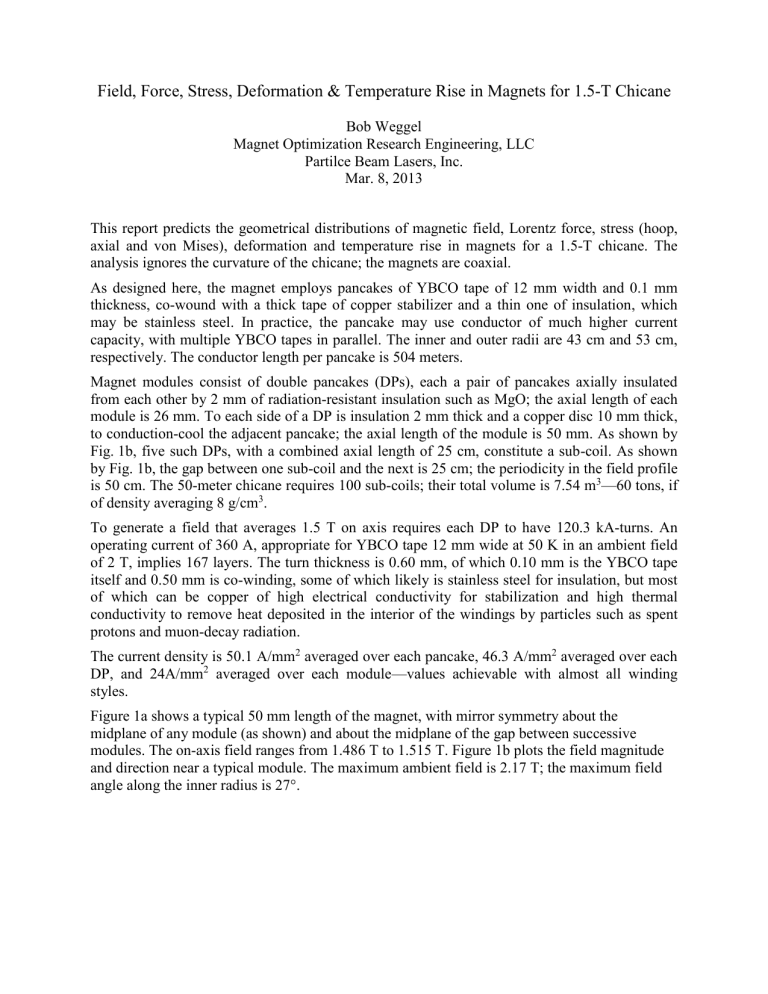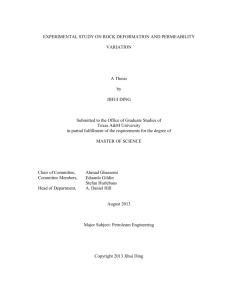Chicane3-7-2013

Field, Force, Stress, Deformation & Temperature Rise in Magnets for 1.5-T Chicane
Bob Weggel
Magnet Optimization Research Engineering, LLC
Partilce Beam Lasers, Inc.
Mar. 8, 2013
This report predicts the geometrical distributions of magnetic field, Lorentz force, stress (hoop, axial and von Mises), deformation and temperature rise in magnets for a 1.5-T chicane. The analysis ignores the curvature of the chicane; the magnets are coaxial.
As designed here, the magnet employs pancakes of YBCO tape of 12 mm width and 0.1 mm thickness, co-wound with a thick tape of copper stabilizer and a thin one of insulation, which may be stainless steel. In practice, the pancake may use conductor of much higher current capacity, with multiple YBCO tapes in parallel. The inner and outer radii are 43 cm and 53 cm, respectively. The conductor length per pancake is 504 meters.
Magnet modules consist of double pancakes (DPs), each a pair of pancakes axially insulated from each other by 2 mm of radiation-resistant insulation such as MgO; the axial length of each module is 26 mm. To each side of a DP is insulation 2 mm thick and a copper disc 10 mm thick, to conduction-cool the adjacent pancake; the axial length of the module is 50 mm. As shown by
Fig. 1b, five such DPs, with a combined axial length of 25 cm, constitute a sub-coil. As shown by Fig. 1b, the gap between one sub-coil and the next is 25 cm; the periodicity in the field profile is 50 cm. The 50-meter chicane requires 100 sub-coils; their total volume is 7.54 m 3 —60 tons, if of density averaging 8 g/cm
3
.
To generate a field that averages 1.5 T on axis requires each DP to have 120.3 kA-turns. An operating current of 360 A, appropriate for YBCO tape 12 mm wide at 50 K in an ambient field of 2 T, implies 167 layers. The turn thickness is 0.60 mm, of which 0.10 mm is the YBCO tape itself and 0.50 mm is co-winding, some of which likely is stainless steel for insulation, but most of which can be copper of high electrical conductivity for stabilization and high thermal conductivity to remove heat deposited in the interior of the windings by particles such as spent protons and muon-decay radiation.
The current density is 50.1 A/mm
2
averaged over each pancake, 46.3 A/mm
2
averaged over each
DP, and 24A/mm 2 averaged over each module—values achievable with almost all winding styles.
Figure 1a shows a typical 50 mm length of the magnet, with mirror symmetry about the midplane of any module (as shown) and about the midplane of the gap between successive modules. The on-axis field ranges from 1.486 T to 1.515 T. Figure 1b plots the field magnitude and direction near a typical module. The maximum ambient field is 2.17 T; the maximum field angle along the inner radius is 27°.
Fig. 1a&b. Field magnitude (color & contours) and direction (arrows) of 50 mm section of chicane with on-axis field that averages 1.5 T, ranging from 1.486 T to 1.515 T. Maximum ambient field = 2.17T.
Figure 2 plots the magnitude and direction of the field at r = 43 cm, the inner radius of the windings. The field magnitude ranges from 1.6 T to 2.17 T; the maximum field angle is 27°.
Fig. 2. Field magnitude (turquoise) & direction (black) at r = 43 cm. |B| max
is 2.17 T; the maximum angle is 27°.
Figure 3a plots the radial component of the Lorentz force, which ranges from −28 to 109 MN/m
3
.
Figure 3b plots the hoop stress, which ranges from 7.7 to 10.4 MPa—a modest 1.5 ksi.
Fig. 3a&b. Left: Radial component of Lorentz force, which ranges from −28 to 109 MN/m 3 . Right: Hoop stress, which ranges from 7.7 to 10.4 MPa.
Figure 4a plots the axial component of Lorentz force, which ranges from −61 to 30 MN/m
3
.
Figure 4b plots the axial component of stress, whose magnitude reaches 1.78 MPa
(compressive).
Fig. 4a&b. Left: Axial component of Lorentz force, −61 to 30 MN/m 3 . Right: Axial stress, with magnitude up to
1.78 MPa (compressive).
Figure 5a plots the von Mises stress, which ranges from 7.6 to 11.0 MPa, dominated by the hoop stress of 7.7 to 10.4 MPa. Figure 5b plots the deformation, which ranges from 37 to 41 microns—very modest for a magnet this large.
Fig. 5a&b. Left: von Mises stress, 7.6 to 11.0 MPa. Right: Deformation (amplified 500 fold), 37 to 41 μ.
Figure 6 plots the temperature rise with a uniform power-deposition density throughout the module of 500 kW/7.54 m
3
= 66 mW/cm
3
. The thermal conductivity, k
Cu
, of the copper discs is
1,000 W/m · K, appropriate for copper of residual resistivity ratio 100 at a temperature of 50 K.
The value assumed for k ins
is 50 kW/m · K. This value should be conservative: Fig. 19 on p. 66 of
The National Standard Reference Data Series 8 , Thermal Conductivity of Selected Materials , compiled by R.W. Powell, C.Y. Ho & P.E. Liley (1966), shows k
MgO
for polycrystalline MgO,
99.5% pure and 98% dense, to be 80 W/m · K at 160 K and improving rapidly with decreasing temperature. “Thermal Conductivity of Neutron-Irradiated MgO,” by D.S. Kupperman, G. Kurz
& H. Weinstock, Journal of Low Temperature Physics, Vol. 12, Nos. 1/2 (1973) reports k
MgO
for pure crystalline MgO at 50 K to be, respectively, [1,300, 300, 130, 40] W/m · K after dosages of
[0, 4x10 17 , 2x10 18 , 2x10 19 ] n/cm 2 . The predicted temperature rises are very modest: 0.75 K if cooled from only the outside, 0.24 K if cooled from both the inside and the outside.
Fig. 6a&b. Temperature distribution in half-module of superconductor and copper discs. Left: Cooled only from outer radius; ∆T max
= 0.75 K. Right: Cooled from both inner and outer radii; ∆T max
= 0.24 K.








